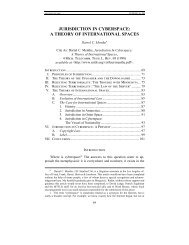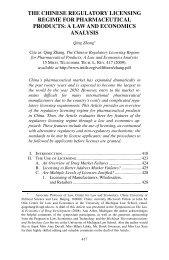Fracking Patents - Michigan Telecommunications and Technology ...
Fracking Patents - Michigan Telecommunications and Technology ...
Fracking Patents - Michigan Telecommunications and Technology ...
- No tags were found...
Create successful ePaper yourself
Turn your PDF publications into a flip-book with our unique Google optimized e-Paper software.
300 <strong>Michigan</strong> <strong>Telecommunications</strong> <strong>and</strong> <strong>Technology</strong> Law Review [Vol. 19:279lab—spillovers <strong>and</strong> externalities—that exist even if the invention is functioningexactly as intended. This need to underst<strong>and</strong> safety through testing isthe rationale behind government pharmaceutical-approval systems, 124 <strong>and</strong>the potential for patents to interfere is the reason behind the specific statutoryinfringement exemption. 125As restricted as the patent environment is in the US, it is possible thatthere may be more international flexibility. 126 Although not required by internationalagreements such as the Agreement on Trade-Related Aspects ofIntellectual Property Agreement (“TRIPS”), 127 many countries have an explicitexperimental use exception whether articulated through statute or commonlaw. 128 The boundaries of permitted use may be wider. 129 Still, it is notentirely clear that the exceptions in other nations extend to safety testing.And while the exception for pharmaceutical experimentation is relativelyestablished globally, 130 it is extremely limited in context <strong>and</strong> cannot providethe flexibility necessary to address safety concerns.Through a combination of litigation <strong>and</strong> tight licensing, patent ownerscan control a great deal of information. With no relief valve available, it thenbecomes more important to assess patent accumulation in fields of greatpublic concern. Because an underst<strong>and</strong>ing of the impact of patents on naturalgas technology is still emerging, it is helpful to look to other contexts for aview of what may come to pass.124. See, e.g., 21 U.S.C. § 355 (2011); Conducting Clinical Trials, U.S. FOOD & DRUGADMIN., http://www.fda.gov/Drugs/DevelopmentApprovalProcess/ConductingClinicalTrials/default.htm (last updated June 22, 2012).125. See 35 U.S.C. § 271(e) (2011); Merck KGAA v. Integra Lifesciences I, Ltd., 545U.S. 321, 202–04 (2005) (describing the pharmaceutical research exemption <strong>and</strong> the need toevaluate information from a wide range of testing).126. See, e.g., Norman Siebrasse & Keith Culver, The Experimental Use Defence to PatentInfringement: A Comparative Assessment, 56 U. TORONTO L.J. 333, 338–40 (2006) (comparingthe U.S. regime with the European approach, <strong>and</strong> concluding that Europe has a broaderexception).127. TRIPS permits limited exceptions so long as they “do not unreasonably conflictwith a normal conflict with a normal exploitation of the patent <strong>and</strong> do not unreasonablyprejudice the legitimate interests of the patent owner.” Agreement on Trade-Related Aspectsof Intellectual Property Rights, Art. 31, Apr. 15, 1994, Marrakesh Agreement Establishing theWorld Trade Organization, Annex 1C, 1869 U.N.T.S. 299, 33 I.L.M. 1197 (1994). However,there is no positive requirement for such an exception, <strong>and</strong> certainly nothing specific to experimentaluse.128. See, e.g., AUSTL. GOV’T ADVISORY COUNCIL ON INTELL. PROP., PATENTS AND EX-PERIMENTAL USE 38–44 (2005) [hereinafter AUSTRALIAN STUDY], available at http://www.acip.gov.au/library/acip%20patents%20&%20experimental%20use%20final%20report%20final.pdf (reviewing the experimental use provisions of the U.S., the U.K, Germany, Japan,Canada, <strong>and</strong> New Zeal<strong>and</strong>); CENTRE FOR INTELL. PROP. POLICY & HEALTH LAW INST., THERESEARCH OR EXPERIMENTAL USE EXCEPTION: A COMPARATIVE ANALYSIS 7–38 (2004), availableat http://www.cipp.mcgill.ca/data/newsletters/00000050.pdf (comparing the experimentaluse provisions of Australia, the U.S., Germany, the U.K, <strong>and</strong> France).129. See Siebrasse & Culver, supra note 126, at 338.130. AUSTRALIAN STUDY, supra note 128, at 44–45.






